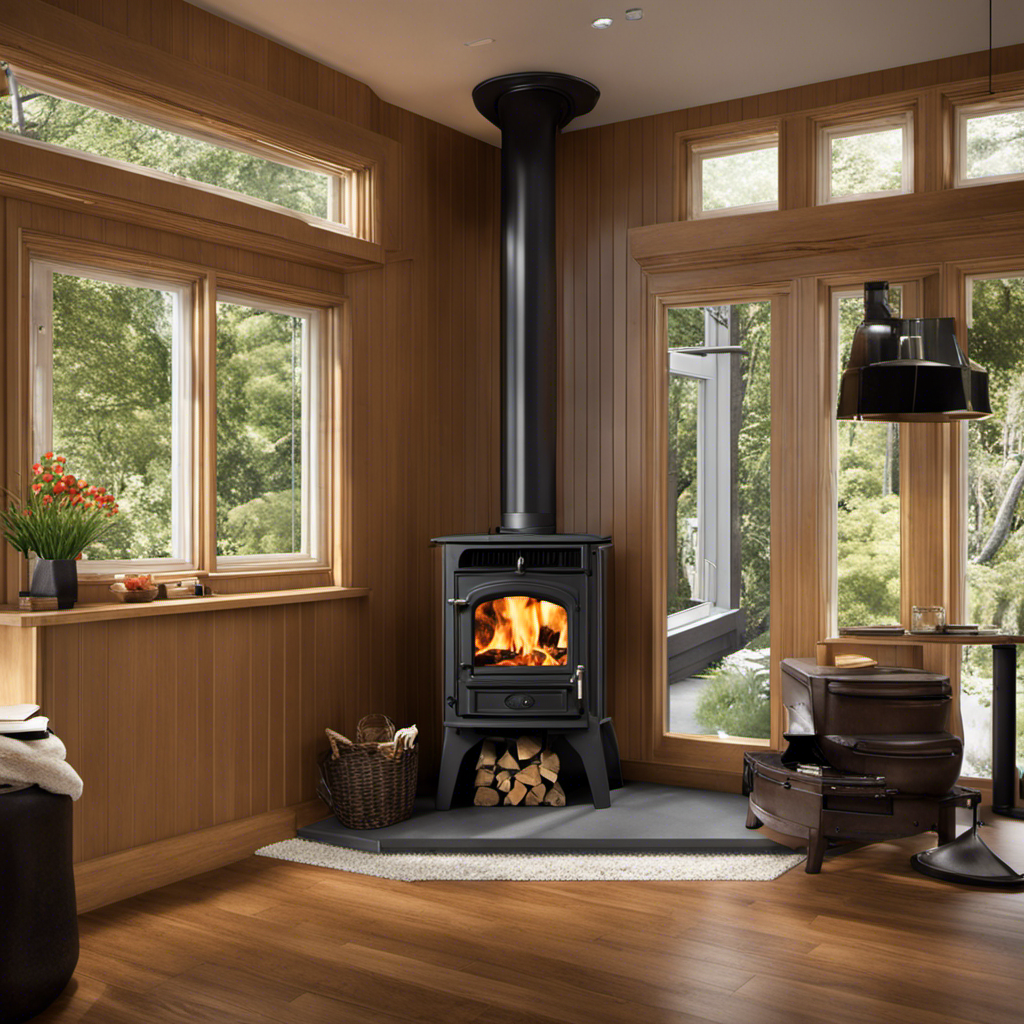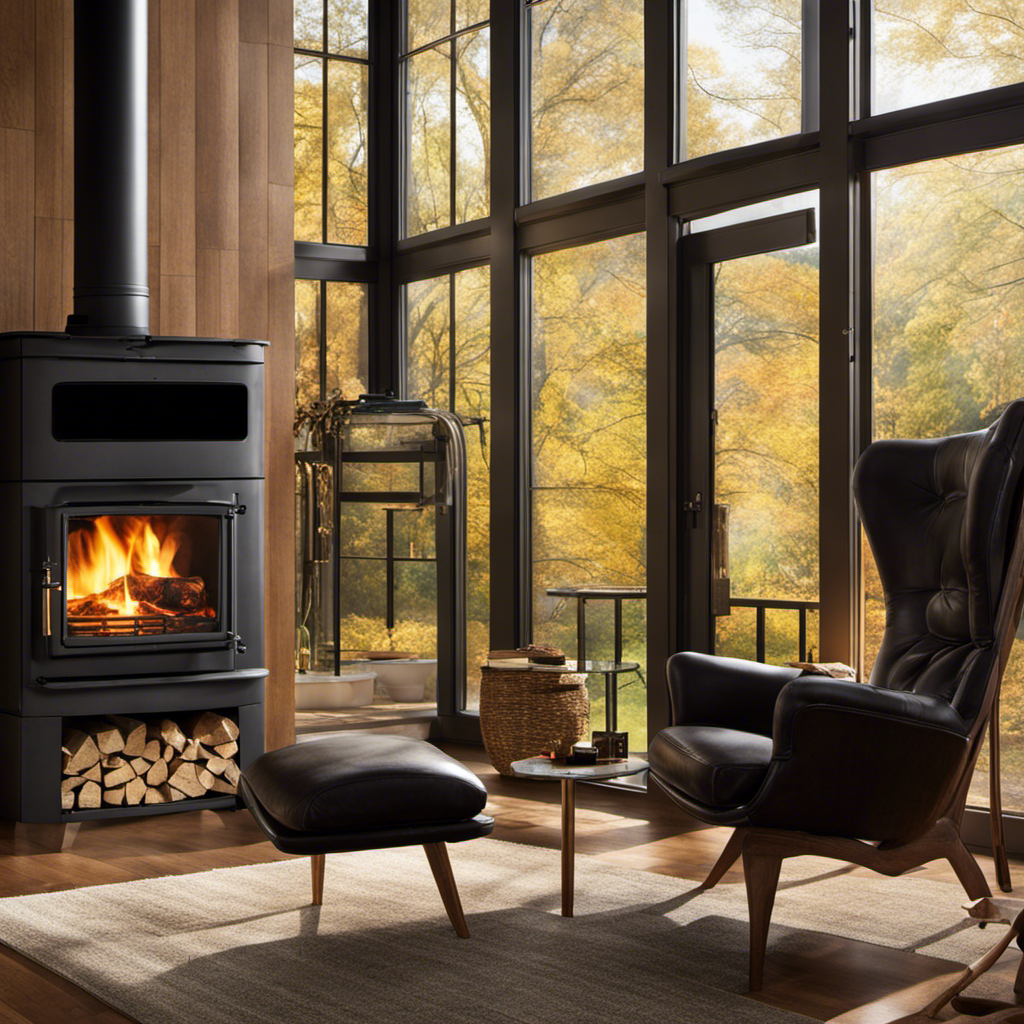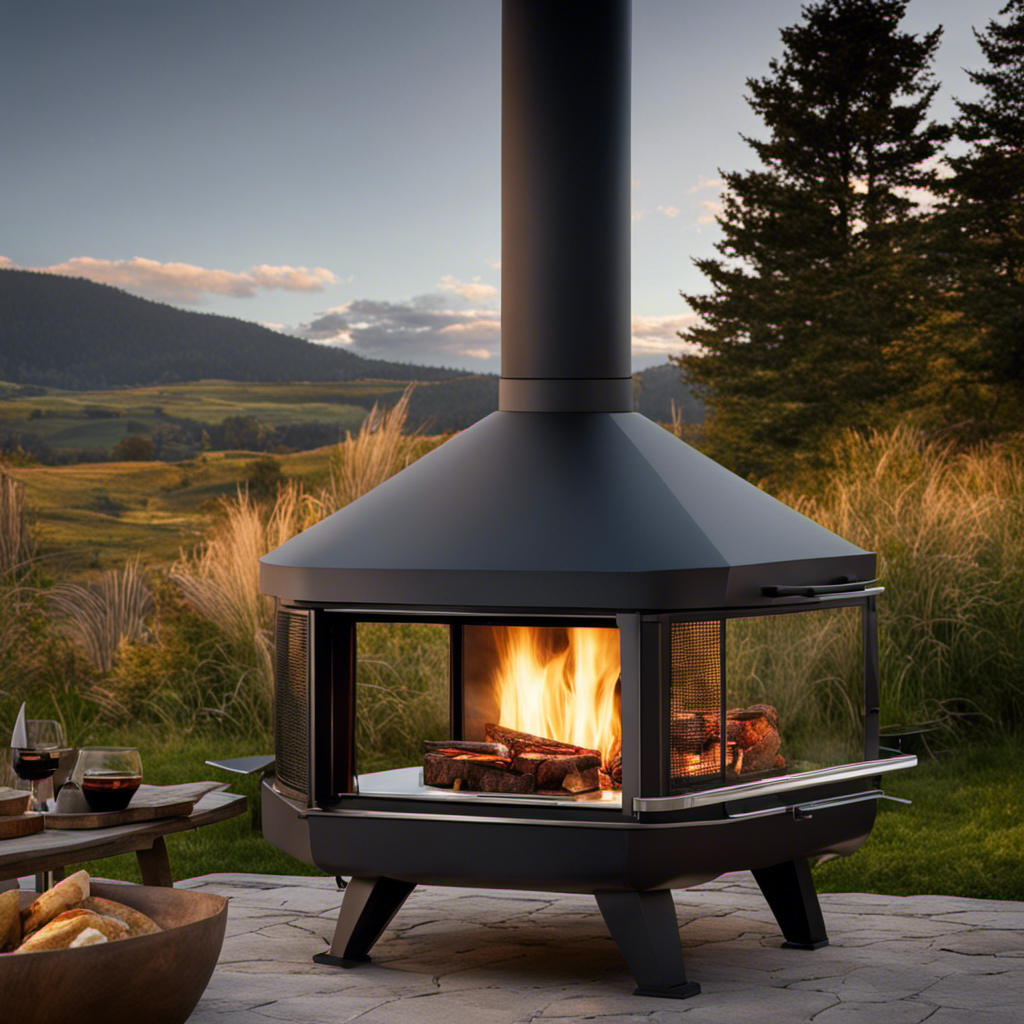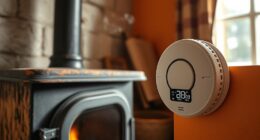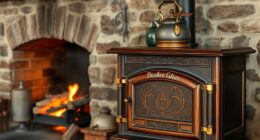Ready to transform your tiny living area into a cozy haven complete with a wood stove? Search no more! This guide will walk you through the critical steps necessary to install wood stoves in small dwellings.
From finding the perfect spot to securing the stove, we’ll leave no stone unturned.
So, grab your tools and let’s dive into the world of wood stove installation. Get ready to embrace warmth and liberation in your very own home!
Key Takeaways
- Properly evaluate the layout and choose the right spot for installation, considering ventilation, clearance requirements, and aesthetics.
- Use heat shields to protect walls and furniture from the intense heat and improve energy efficiency and fire safety.
- Follow proper techniques for cutting the roof penetration and installing the ventilation system to ensure safety and prevent hazards.
- Secure the stove to the floor, check for potential leaks, run a first fire test, and prioritize regular maintenance for optimal performance and safety.
Finding the Right Spot
We’ve been researching different areas in our living room to find the perfect spot for our wood stove.
When it comes to finding the right location, there are a few important factors to consider.
First and foremost, you need to ensure that the area has proper ventilation. This is crucial for the safe operation of the wood stove and to prevent the buildup of harmful gases, such as carbon monoxide. Look for a spot near an exterior wall where you can easily install a vent or chimney.
Additionally, consider the layout of your living room and how the stove will fit in with your existing furniture and décor.
Finding the right location is essential for both functionality and aesthetics, so take the time to carefully evaluate your options.
Clearing a Safe Area
Have we cleared enough space around the wood stove to ensure a safe area? Ensuring proper clearance requirements and fire safety precautions are crucial when installing wood stoves in compact homes. It is important to create a safe environment that minimizes the risk of fire and allows for efficient operation. To help guide you in this process, we have provided a table outlining the recommended clearance requirements for different components of a wood stove installation:
| Component | Clearance Requirement |
|---|---|
| Back Wall | 18 inches |
| Side Walls | 36 inches |
| Combustible Materials Above | 36 inches |
Installing Heat Shields
When it comes to installing heat shields, there are a few crucial points to keep in mind.
First, the choice of heat shield materials is important to ensure maximum safety and efficiency.
Second, proper installation techniques are key to ensure the heat shield is securely attached and provides adequate protection.
Lastly, it’s essential to follow the manufacturer’s guidelines and local building codes to ensure a successful installation.
Heat Shield Materials
The heat shield materials are essential for protecting our compact home from the intense heat of the wood stove. They serve as a barrier, preventing the heat from damaging the surrounding walls and furniture. Here are four key reasons why heat shield materials are crucial for a safe and effective wood stove installation:
-
Heat Protection: The primary purpose of a heat shield is to protect the walls and other combustible materials from the extreme temperatures generated by the wood stove.
-
Energy Efficiency: By reflecting the heat back into the room, heat shield materials improve the overall efficiency of the wood stove, ensuring that more heat is utilized rather than lost.
-
Fire Safety: Installing a heat shield significantly reduces the risk of fire accidents, as it creates a non-combustible barrier between the stove and the surrounding materials.
-
Aesthetics: Heat shield materials come in various designs and finishes, allowing you to choose one that complements the style of your compact home.
Proper installation techniques are crucial for maximizing the effectiveness of the heat shield and ensuring the safety of your home.
Proper Installation Techniques
We need to carefully follow the proper installation techniques in order to ensure the effectiveness and safety of our heat shields.
When installing heat shields, proper positioning is crucial. The heat shield should be placed at least 18 inches away from the combustible material, such as wood or drywall. This ensures that the heat is dispersed evenly and prevents any potential fire hazards.
Additionally, it’s important to take safety measures during installation. Wearing protective gear, such as gloves and goggles, can prevent any injuries. Following the manufacturer’s instructions and using the recommended tools and materials will also guarantee a proper installation.
By adhering to these guidelines, we can ensure the optimal performance of our heat shields and create a safe environment for our compact homes.
Now let’s move on to the next step: cutting the roof penetration.
Cutting the Roof Penetration
When it comes to cutting the roof penetration for installing a wood stove, there are several crucial points to consider.
First and foremost, we need to prioritize roofing safety precautions to ensure a secure and stable installation process.
Additionally, proper ventilation requirements must be met to prevent any potential hazards, such as carbon monoxide buildup.
Lastly, sealing and insulation techniques play a vital role in maintaining a comfortable and energy-efficient indoor environment.
Roofing Safety Precautions
Our team always takes roofing safety precautions seriously when working on cutting roof penetrations. Safety is our top priority, and we understand the importance of following proper procedures to ensure the well-being of our team members and the success of the project.
Here are four crucial safety measures we take when working with roofing equipment and tools:
-
Personal Protective Equipment (PPE): We ensure that all team members wear appropriate PPE, including hard hats, safety glasses, gloves, and non-slip footwear. This protects them from potential hazards and reduces the risk of accidents.
-
Fall Protection: We use fall protection systems such as harnesses, lanyards, and anchor points to prevent falls from roofs. This is especially important when working at heights or on steep slopes.
-
Tool Safety: We regularly inspect and maintain our roofing tools to ensure they’re in good working condition. This includes checking for any damage or defects that could pose a safety risk.
-
Proper Training: Our team undergoes regular training sessions to stay updated on the latest safety practices and techniques. This helps us identify potential hazards and respond appropriately in any situation.
Proper Ventilation Requirements
The importance of following the proper ventilation requirements for cutting the roof penetration can’t be overstated. When it comes to compact homes, ensuring adequate ventilation is even more crucial due to the limited space available.
Proper ventilation is essential to maintain a healthy and comfortable living environment, as it helps remove excess moisture, odors, and pollutants from the air. In compact homes, where space is at a premium, it’s necessary to carefully plan and design the ventilation system to maximize efficiency and effectiveness.
This may involve the use of mechanical ventilation systems, such as exhaust fans or ventilation hoods, as well as natural ventilation methods, such as windows or vents. Additionally, it’s important to regularly inspect and maintain the ventilation system to ensure it’s functioning properly and providing adequate airflow.
Sealing and Insulation Techniques
We will use high-quality sealing and insulation techniques to ensure a tight and energy-efficient seal around the roof penetration. Proper sealing and insulation are crucial for the installation of wood stoves in compact homes.
Here are four key techniques we’ll employ:
-
Weatherstripping: We’ll apply weatherstripping around the roof penetration to prevent air leakage and maintain a consistent indoor temperature.
-
Caulking: Our team will use high-grade caulking to seal any gaps or cracks in the roof penetration, ensuring that no heat escapes and no cold air enters the living space.
-
Insulation materials: We’ll utilize insulation materials, such as spray foam or fiberglass, to effectively insulate the area around the roof penetration and reduce heat loss.
-
Thermal barriers: To further enhance energy efficiency, we’ll install thermal barriers around the chimney pipe to prevent heat transfer to adjacent materials.
By implementing these sealing techniques and insulation methods, we’ll create a well-insulated and airtight system, maximizing the efficiency of the wood stove installation.
This seamless transition sets the stage for the next step: installing the chimney pipe.
Installing the Chimney Pipe
We need to measure the length of the chimney pipe before installing it in order to ensure a proper fit. Proper chimney installation is crucial for the safe and efficient operation of wood stoves in compact homes.
When it comes to chimney height requirements, it’s important to consider local building codes and regulations. These requirements are in place to ensure that smoke is properly vented and doesn’t pose a risk to the occupants or neighboring properties. The height of the chimney must be adequate to create proper draft and prevent backdrafting.
It’s also important to consider the distance between the chimney and any combustible materials to prevent fire hazards. By following these guidelines, we can ensure a safe and effective wood stove installation in our compact homes.
Securing the Stove to the Floor
After inspecting the floor, we should secure the stove using anchor bolts, ensuring it remains stable during use. Securing a wood stove is crucial for the safety and efficiency of your compact home. Here are four essential steps to follow when securing your stove:
-
Choose the right anchor bolts: Select strong and durable anchor bolts that are appropriate for the weight of your stove. Consult the manufacturer’s guidelines for the recommended size and type.
-
Locate the ideal position: Determine the best spot for your stove, considering factors such as proximity to combustible materials and proper ventilation. Mark the location on the floor.
-
Prepare the floor: Ensure the floor is clean and level. Use a drill to create holes in the marked spots, matching the size of the anchor bolts.
-
Secure the stove: Place the stove over the drilled holes and insert the anchor bolts through the stove’s base and into the floor. Tighten the bolts securely to ensure stability.
By following these securing methods and taking necessary measures for floor protection, you can enjoy the warmth and comfort of your wood stove while ensuring the safety of your compact home.
Stay liberated and cozy!
Checking for Potential Leaks
Let’s start by thoroughly inspecting the stove and its connections to ensure there are no potential leaks. When it comes to wood stoves, safety is of utmost importance. Potential dangers such as gas leaks or carbon monoxide poisoning can pose serious risks to our well-being.
To mitigate these risks, it’s crucial to take appropriate safety measures. Begin by carefully examining the stove’s connections, including the chimney, pipes, and ventilation system. Look for any signs of wear and tear, loose fittings, or cracks that could potentially lead to leaks. Additionally, ensure that all connections are secure and properly sealed.
It’s also essential to regularly check and maintain the stove to prevent any potential dangers. By being vigilant and thorough in our inspections, we can ensure the safety and well-being of everyone in our compact homes.
Running a First Fire Test
During the first fire test, we should carefully observe the stove’s performance and ensure that it’s operating efficiently. Here are some essential tips for conducting a safe and successful first fire:
- Safety first: Before starting the fire, make sure you have a fire extinguisher nearby and clear any flammable materials from the stove’s vicinity.
- Check for proper airflow: Ensure that the air vents and chimney are clear to allow for adequate airflow, which is crucial for efficient combustion.
- Monitor temperature: Keep an eye on the stove’s temperature to prevent overheating and potential damage to the surrounding area.
- Address any issues: If you notice any abnormal behavior, such as smoke coming into the room or a weak flame, troubleshoot the problem immediately to ensure safety.
Running a first fire test is crucial for identifying potential issues and ensuring the safe operation of your wood stove. Regular maintenance is equally important to maximize its efficiency and lifespan.
What are the key differences in installing a Fisher wood stove compared to other types of wood stoves in compact homes?
When installing Fisher wood stoves in compact homes, sizing is crucial. These stoves need proper clearances to combustible materials. Unlike other wood stoves, Fisher stoves have a unique design and may require more space for the flue pipe. Proper installation of Fisher wood stoves ensures safety and efficient heating.
Importance of Regular Maintenance
We should prioritize the importance of regular maintenance in order to ensure the efficient operation and longevity of our wood stove.
Regular cleaning is essential to keep our wood stove functioning optimally and to prevent potential health hazards.
When we neglect regular cleaning, soot and creosote can accumulate in the chimney, increasing the risk of chimney fires.
Additionally, a buildup of soot and debris inside the stove can hinder proper airflow and lead to poor combustion, resulting in lower heat output and increased smoke emissions.
By regularly cleaning the chimney, flue, and stove, we can minimize the risk of chimney fires, improve air quality in our homes, and maximize the efficiency of our wood stove.
It’s crucial to prioritize regular maintenance for both the safety of our homes and our overall well-being.
Frequently Asked Questions
How Much Clearance Is Required Between the Wood Stove and Combustible Materials?
For wood stove safety and proper wood stove installation, it’s crucial to have the right clearance between the wood stove and combustible materials. We’ll cover the specifics in our detailed installation guide.
Can a Wood Stove Be Installed in a Mobile Home?
Yes, a wood stove can be safely installed in a mobile home. It is crucial to follow proper installation guidelines, ensuring proper ventilation, clearances, and compliance with local codes for the safety of the occupants.
What Are the Different Types of Heat Shields and How Do They Work?
There are different types of heat shields that can be used when installing wood stoves. They serve the purpose of protecting the surrounding walls and floors from excessive heat generated by the stove.
Are There Any Specific Regulations or Permits Required for Installing a Wood Stove in a Compact Home?
There are specific regulations and permits required for installing a wood stove in a compact home. We’ll guide you through the process, ensuring compliance and providing the necessary documentation for a successful installation.
What Are the Signs of a Potential Chimney Leak and How Can It Be Fixed?
When it comes to chimney leak repair, there are several signs to look out for, such as water stains on the ceiling or walls. Common causes of chimney leaks include cracked chimney crowns or damaged flashing. Proper repair is essential to prevent further damage.
Conclusion
In the dance of installing a wood stove in a compact home, each step is crucial, like the footsteps of a seasoned ballroom dancer.
From finding the perfect spot to securing the stove and checking for leaks, attention to detail is key.
Just like a graceful waltz, regular maintenance keeps the fire burning brightly and the home cozy.
So, take these steps with confidence, and let the warmth of the wood stove embrace your compact space.
Logan’s affair with adventure began in childhood. He hailed from a small town where vast forests bordered one side and endless shores stretched on the other. His days were spent exploring uncharted woods, climbing tall trees, or listening to the tales of old sailors. This early immersion in a world brimming with stories and mysteries became the foundation of his passion for writing.

